Although socks is a small part of the average person’s wardrobe, they take up a great share in the fashion industry. Socks can be a good beginner product for new business starters with so many aesthetics, functions and customer demand – it’s easy to find a niche field of the market to sell to.
Before you start the sock business, it is basic to know how the factories produce socks and how much investment fund you should expect. Therefore, we visited the third largest sock factory in China, and create this article to explain in detail how socks are produced and give you a basic idea of the cost of socks production.
To give you a visual idea about how pantyhose are made from yarns, we have recorded this video when we are visiting the third-largest sock factory in China. We have also uploaded it on Youtube, you can check it out if you are interested.
Step 1. Confirm the details of the sock you want to produce
First of all, what parameters does the factory need to know about the socks before they start to produce the sock? The following is the information you should provide to the factory.
Specification of socks
As socks can be designed for different people and different purposes, such as boat docks, children’s socks, women’s socks, and men’s socks, the length and the bottom size various. So the most basic thing is to tell the factory the specifications of socks.
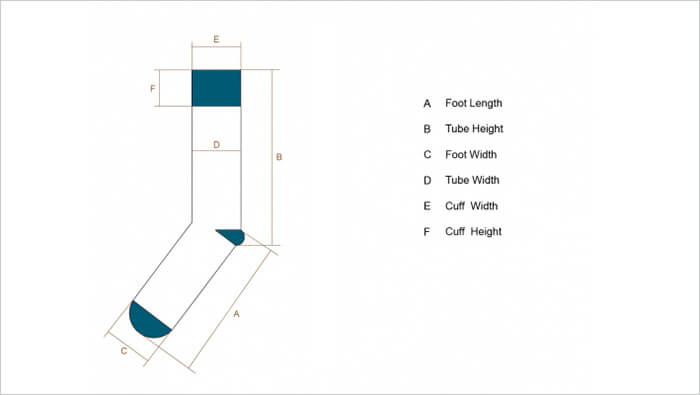
Patterns on the sock
The pattern on the sock can be a pattern you designed or you liked, it also can be the logo of your brand. You can also customize solid-colored socks, and the cost of plain socks is lower than patterned socks.
After the factory confirms the specific details and parameters of the socks with you one by one. After that, the factory can proceed to the next step — setting up the textile process.

The fabric of the sock
(1) The main materials: The main material for sock fabrics can be cotton, modal, wool, viscose rayon, and so on. Each of them has its own advantages and characteristics.
But the most common sock in the market is mainly cotton-blending. Cotton content from 50% to 85%, the cost of socks also fluctuates according to the cotton content, the higher the cotton content, the more expensive the cost.
(2) Auxiliary materials: besides the main content of cotton or wool, some functional fibers need to be blended in to maintain elasticity, fastness, and comfort of socks. Polyester, spandex, polyamide are very common functional fibers.
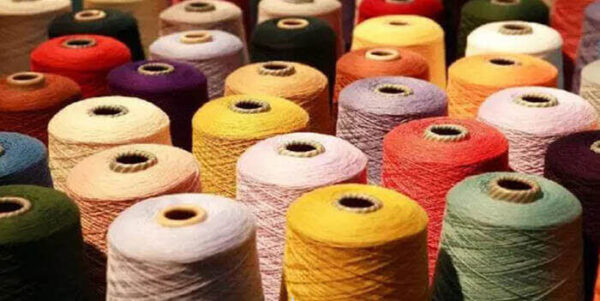
For your customized socks, you can provide the factory the fabric composition. For example, if you want cotton 50%+25%acrylic+5%Nylon, the factory will allocate yarns to make socks according to your requirements.
Alternatively, you can let the factory know what kind of sock you want, such as more comfortable socks, more solid sock or more cost-effective socks, and the factory will arrange different percentages of different yarns to achieve your requirements.
Step 2. Knit the unstitched sock
How to make socks above the ankle
The factory selects yarns of various materials and colors, and technicians will compile the confirmed socks parameters (yarns of various percentage content, patterns, needle number, etc.) into the program code and input it into the sock machine. The machine will read the code and weave yarns into toe unstitched socks.
The machine can be set to different needles model, which determines the widths of the socks? The more needles, the greater the horizontal stretch of the sock.
- Regular sock: 84N-276N
- Silk Sock: 320N-402N
- Thickened pantyhose: 560N,600N
At the same time of weaving, workers will patrol in the workshop, and check the socks coming out of the machine to see whether there are holes, stains or pattern errors on the surface, and sort out the socks without defects and take them to the next process – sewing.
Most of the times, these machines operate the clock around, with one worker responsible for every 20 machines, thus the workers will also have day and night shifts to manage the socks produced by the machines.
The production capacity of each knitting machine
Adult socks: Plain socks– about 380 pairs per day, Patterned socks–about 240 pairs per day
Children socks— about 400 pairs per day
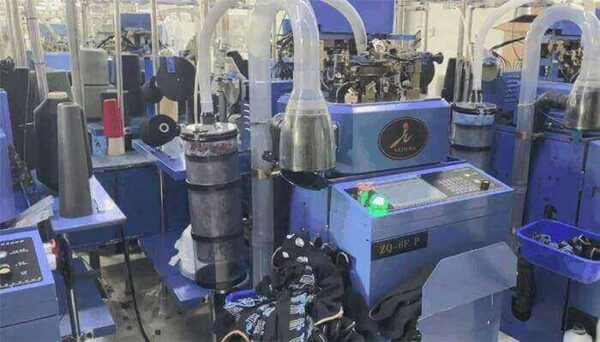
How to make no show sock:
No show sock the shape of a special sock, it can be made in two ways.
Knit the shape by machine
The process of machine making no show socks is literally the same as the regular sock making the process. It’s just that workers should adjust the knitting machine’s mode to produce toe unstitched no show socks.
Trim the sock shape by hand
Knitting machine produces the ankle-length socks first, and workers will cuts off the extra fabric and make the ankle-length sock into no show length, then wrap the edges and sew the toe opening. And finally, we get a no show sock.
As the hand-stitched no show socks with edges are made of a stretch band, they are less likely to slip off and can cover the feet better.
Step 3. Sew the socks in the toe opening
The position and method of the sewing of different socks are different. Let’s take a look at three common sock stitching processes
Regular socks – machine sewing
Now that we have the semi-finished socks, we can soon get wearable socks as long as we sew the sock on the toe parts. Firstly, the socks should be turned inside out, so that no trace of sewing can be seen on the surface of the socks.
Then, the worker will align the opening and put it in the sewing machine manually, and the machine will sew efficiently. As the process of sewing regular socks is simple, factories usually leave it to machines.
It is worth mentioning that the work of the workers is also important because if the worker pulls too hard or too light on the toe opening, the stitching will be uneven. Besides, the yarn color of the seam is not chosen randomly but should be consistent with the color of the sock toe part, otherwise, the seam trace will be obviously seen on the surface.
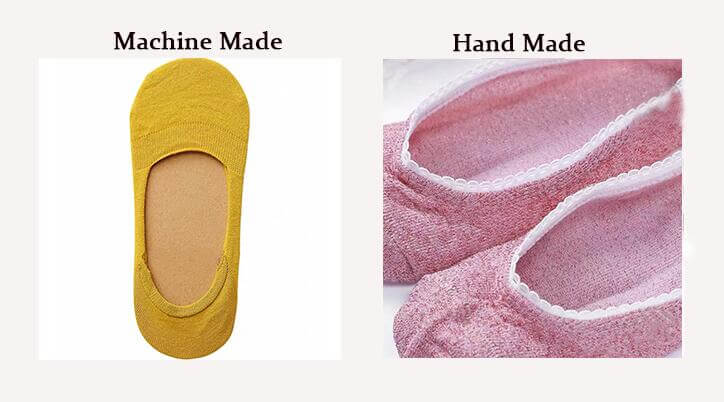
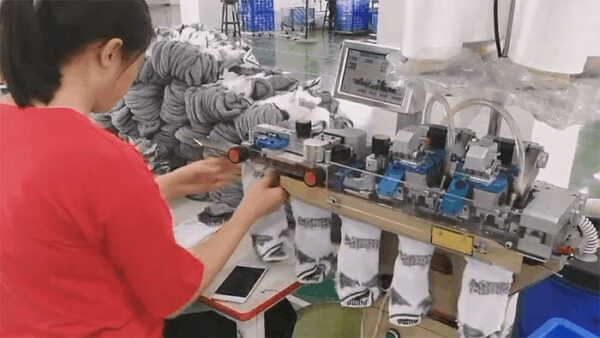
Seamless sewing –hand sewing
Machine sewing is more efficient than manual sewing, however, it is not flawless. Machine-sewn socks inevitably will have a trim inside the toe part, which will affect the comfort of wearing, especially for children sock and sports socks, this tiny thread affect great. While hand-sewn socks are smooth in the sewing part.
Hand-sewing seamless sock costs more $30 cents per pair than machine sewing sock, but the retail price of hand-made socks is also higher. As to which kind of craft to choose depends on the consumption level and consumption-ability of your target consumers.

Pantyhose sewing– semi-hand sewing
The sewing process for pantyhose is more complicated. Besides sewing the toe parts, it also needs to be cut on the crotch and stitch two pieces of long socks together to form a single pant.
As the process is complicated, the size of the machine is large and the cost is higher, most factories prefer to leave the sewing process to the workers rather than machines.
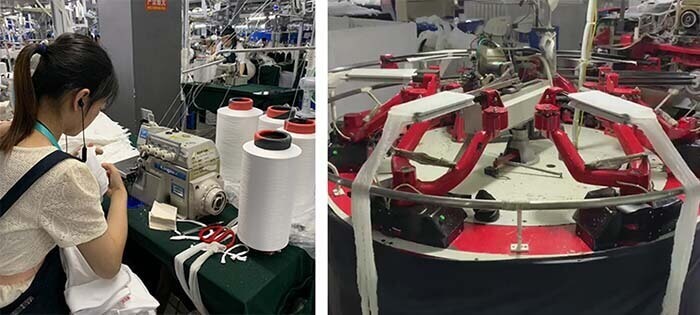
Step 4. Dye the colors
As regular socks are woven from colored yarns, so before knitting regular colored sock, the yarns will be dyed into the color we need. While pantyhoses are woven from white yarn, it is the ready-made stocking need to be dyed to achieve the required color.
Match and modulate the color
The factory will make the color for the main color of the socks and the color of the pattern. In order to reduce the color difference, the factory usually uses a Pantone color card and Miyama color card to confirm the color. There are serial numbers for each color, so you only have to give the serial number of your color to the factory. The workers will modulate the dye according to the color you required.
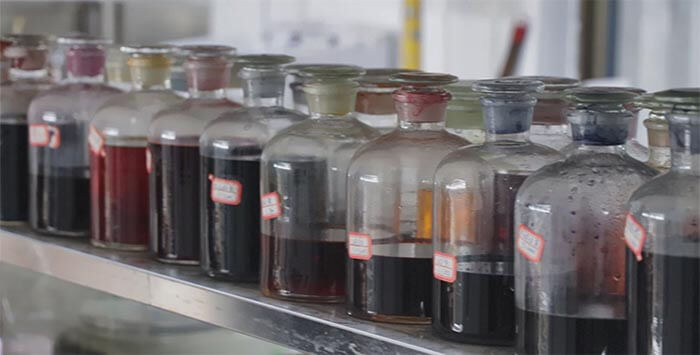
Dye the socks in the dyeing machine
After the dye ready, both the socks and the dye will be put into the high-temperature dyeing machine to be heated. The highest dyeing temperature is around 220 ° c, and the dyeing time varies according to the color of the socks, which usually takes 2-4 hours.
Generall,one dye vat can dye 400 pairs of socks each time. When dying pantyhoses, workers will put them into several laundry bags in case of uneven dying or silk snagging.
Step 5. Shape the sock
The purpose of the boarding process is to keep the socks in good shape so that they can easily be paired and packed. Workers will put each sock on the mold, and the mold rotates passes through the machine to be heated and pressed,thus the socks come out very flat without any wrinkles as if it had been ironed.
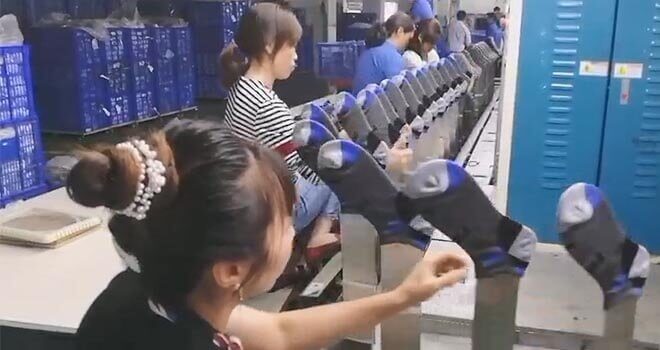
Step 6. Inspect the quality and package the sock
The last but not the least step is to pack the sock with exquisitely designed labels and packagings. At the same time as packaging, workers will also carefully check the quality of the socks to see if there are any flaws like length, trimming, interlocking, etc.
As for pantyhoses, they are particularly fragile and most are flesh-colored and black, it is difficult to check the quality by naked eyes, so the examination of pantyhoses needs to be carried out under the light.
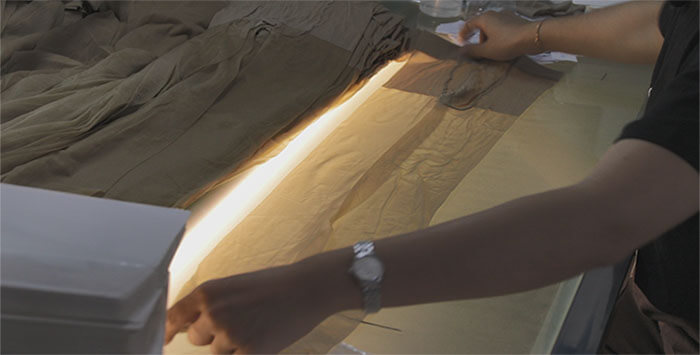
Regular socks packaging
For the most common packaging, the workers will use the swiftach to sew the tag printed with logo to the folded socks, so that the folded socks won’t get messy. Finally,the socks will be packed into transparent OPP bags.
Pantyhose packaging
Pantyhose is easy to hook, so it is not suitable to be pinned with card paper. It is usually folded and put in various PP bags or small paper boxes.
No show socks packaging
In most cases, the no show socks need to be held open with cardboard, in order to present the shape and pattern of the socks to customers more intuitively.
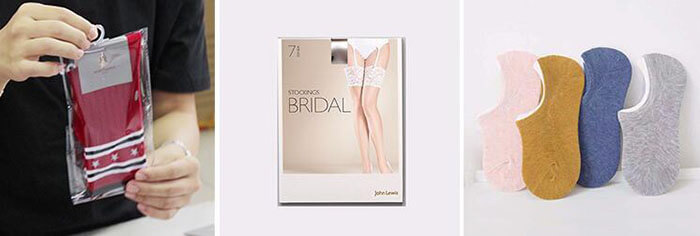
The End
Thanks for your reading, I hope this article can be helpful to your business. If you have some confuses, you can leave a comment and we would love to give you the answer. You can also submit an inquiry if you have the plan to wholesale or customize socks.
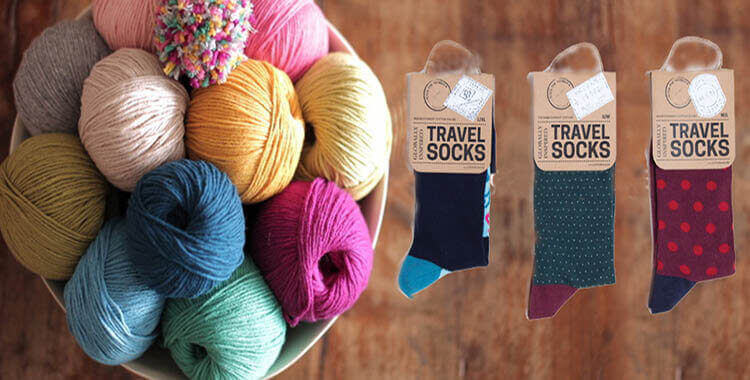

Peculiar article, just what I needed.
Thank you, very interesting article. I want to try to wholesale socks.
Hi Dmitry,
Welcome to email us and our sock sourcing specialist will help you.
I’m about to enter the socks industry in Myanmar. I just had an interview with a company there today. This valuable information really helped me a lot. Thank you so much!
Very detailed socks knowledge, Thanks.
Fascinating. Definitely bookmarking this page. Really valuable info, thanks for posting.
Interesting and thanks for the glimpse of what goes into the making of socks. My favorite being no show socks with cotton being the higher percentage in the mix.
Hi Nyathi. Do you need to import these socks?
You’re really so helpful with your selfless kind blogs and articles to many novice and professionals in business.
Please, i want to work with you as a partner & affiliate in Nigeria in such a business oriented manner.
Hmmn…this is an education. Thanx
Thank you for your support!